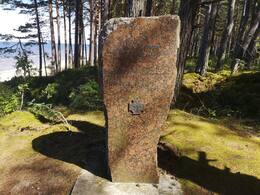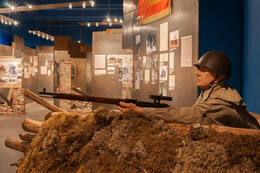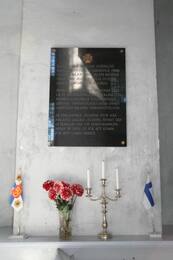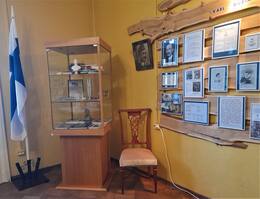Apie suomių jėgerius Latvijoje
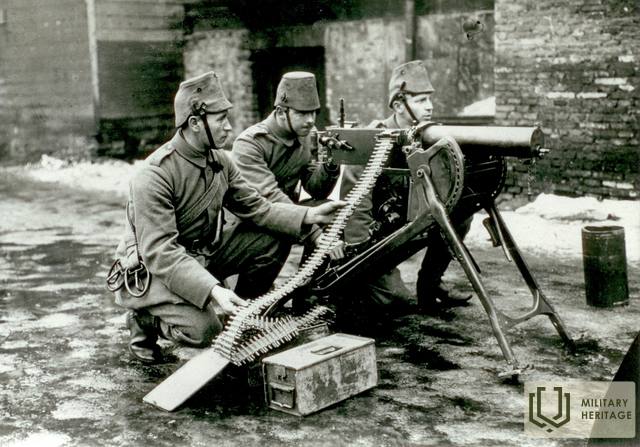
Suomijos jėgerių istorija įdomi, nes ji itin panaši į Latvijos kareivių likimą Pirmajame pasauliniame kare ir jų didelę svarbą kuriant nacionalinę valstybę. Suomiams Pirmasis pasaulinis karas taip pat buvo galimybė padėti pamatus Suomijos nepriklausomybei ir sukurti savo armiją. Šaltinyje aprašomas įvykis, kai Latvijoje atidengiamas paminklas Suomijos jėgeriams.
„Šių metų rugsėjo 7 d. Klapkalncieme, pajūryje, maždaug už 15 kilometrų nuo Smārdės stoties, buvo palaidoti 5 27-ojo jėgerių bataliono suomių šauliai: FV Heinonenas, Viktoras Kami, Emīlsas Kantola, Eikarsas Minti ir Konrādas Pērssonas, kurie savanoriais kovojo Didžiajame pasauliniame kare ir žuvo 1916 m. Suomijos vyriausybė norėjo pastatyti paminklą šiems kovotojams ir taip pagerbti tuos, kurie tikėjosi iškovoti savo tautai nepriklausomybę. Kadangi Latvijos gynybos draugija jau 1925 m. pastatė paminklą suomių šauliams Galinių namuose (Olainės apylinkėse), Suomijos šaulių sąjunga per vietos Suomijos ambasadą paprašė draugijos taip pat pastatyti paminklą Klapkalncieme, ką draugija mielai ėmėsi, siekdama skatinti gerus Suomijos ir Latvijos santykius. Paminklo granito dalys buvo atvežtos iš Suomijos ir su dideliais sunkumais turėjo būti pristatytos į Klapkalnos kaimo pajūrį, palei...“ blogi keliai ten. Po savaičių darbo ir didelių išlaidų paminklas buvo pastatytas, o jo aplinka papuošta. Pašventinimo dieną (rugsėjo 7 d.) į Klapkalną išvyko: Suomijos pasiuntinys Latvijoje Hininenas, Suomijos generalinio štabo viršininkas pulkininkas V allenius, kuris taip pat yra Suomijos šaulių sąjungos pirmininkas; informacijos skyriaus viršininkas pulkininkas leitenantas Relandersas, karinis atstovas pulkininkas Helsingius; Suomijos gailestingumo seserys ir gvardijos Munkė ir Rompanenas; mūsų armijos vado štabo viršininko pavaduotojas pulkininkas Hartmanis su adjutantu kapitonu Kalniniu ir Latvijos gynybos draugijos valdybos nariais. Pakeliui kilo problemų su automobiliais, kurie sugedo dėl blogų kelių, negalėjo pravažiuoti sugriuvusių tiltų ir viadukų. Vairuotojai į šventės vietą atvyko 3 valandas vėliau. Gausiai susirinko vietos gyventojai. Mūsų ir Suomijos vėliavos plevėsuoja aukštose girliandose keturiuose paminklo kampuose; stiebai papuošti girliandomis ir gėlėmis, kurias pagamino... darbščios Klapkalnietės, nepaisant blogo, lietingo oro. Iškilmes suomių ir vokiečių kalbomis atidarė Suomijos pasiuntinys Hininenas, paaiškindamas paminklo prasmę ir nuoširdžiai padėkodamas Latvijos gynybos draugijos valdybai už pastangas statant paminklą. Pasiuntinys padeda didingą vainiką su Suomijos tautine juostele. Tada prabyla pulkininkas Valenius ir baigia savo kalbą latvių kalba, tardamas šiuos reikšmingus žodžius: „Šis paminklas, po kuriuo paguldyti Suomijos jėgeriai, turėtų būti ženklas jaunimui, kad jie turėtų būti pasiruošę atkakliai kovai už savo žemės laisvę ir nepriklausomybę. Latvijos piliečiai, jūs išlaisvinote savo žemę aršiose kovose, todėl „kaip ir mes, suomiai, tegul paminklas mums primena mūsų laisvių vertę ir brangų išpirkimą. Mes niekada neatsisakysime savo nepriklausomybės.“
Pažymėtina, kad Suomijos generalinio štabo viršininkas pulkininkas Vallenius ir pulkininkas leitenantas Relanderis abu kovojo jėgerių gretose ir tiesiogiai šioje mūšio zonoje, todėl liko ir prisimins savo mūšius. Tolimi Suomijos svečiai nuoširdžiai padėkojo vietos Saklauskų namo šeimininkei Alvīnai Guņai ir jos vyrui už kruopštų kapų priežiūrą ir patikėjo jiems šias pareigas ateityje. Šventės dalyviai į Rygą grįžo per Tukumą, nes ten kelias geresnis.“
Laikraštis „Aizzargs“. Klapkalnso žuvusių suomių šaulių paminklų atidengimas. 1929 m.
Susijusi laiko juosta
Susijusios temos
Susijusios vietos
Paminklas suomių jėgerių-saperių atminimui
Įsikūręs Engurės savivaldybėje, A10 greitkelio pakraštyje, netoli Smārdės smuklės.
Memorialas yra lauke priešais Smårde barą, kur 1916 m., Pirmojo pasaulinio karo metu, įvyko Smårde mūšis. Kovose Vokietijos armijos sudėtyje dalyvavo suomių jėgerių inžinerinė kuopa (apie 200 vyrų). „Smårde diena“ tapo oficialia Suomijos armijos karo inžinierių švente, kuri švenčiama ir šiandien.
Suomijos jėgeriai buvo Vokietijos armijos dalinys, suformuotas Pirmojo pasaulinio karo metu. Juos daugiausia sudarė nacionalistiškai nusiteikę suomių savanoriai iš Rusijos imperijos ir Suomijos. Smårde mūšis buvo vienas reikšmingiausių suomių jėgerių puolimo mūšių, kuriame tuo metu buvo naudojama nauja taktika.
Praėjus mėnesiui po šio įvykio, Rusijos armija puolė vokiečių armiją netoli Smārdės. Latvijos koviniai daliniai atliko Smārdės apylinkių žvalgybą, nutiesė tiekimo kelią „Latvijos kelią“ per pelkę ir dalyvavo kovose. Mūšiuose žuvo apie 300 latvių kovotojų. Kaip ir suomių jėgeriai vokiečių armijoje, latvių šauliai Rusijos armijoje buvo savo nacionalinių valstybių ir armijų kūrėjai.
Latvijos karo muziejus
Latvijos karo muziejus yra įsikūręs senamiestyje, netoli Laisvės paminklo, istoriniame gynybos pastate, vadinamame „Parako bokštu“. Muziejuje yra 11 eksponatų. Čia eksponuojami įvairūs ginklai, dokumentai, uniformos, apdovanojimai, ženkleliai ir kiti daiktai, pasakojantys apie kasdienį kareivio gyvenimą kare. Latvijos karo muziejus yra vienas seniausių muziejų Latvijoje. Jo ištakos siekia Pirmąjį pasaulinį karą. Muziejaus kolekciją daugiausia sudarė asmeniniai kareivių daiktai arba mūšio laukuose rasti daiktai. Latvijai atgavus nepriklausomybę, pagrindinis muziejaus tikslas tapo sukurti ekspoziciją apie Latvijos karo istoriją ir aktyvų gyventojų vaidmenį saugant savo žemę. 1937 m. muziejus buvo išplėstas ir techniškai buvo vienas moderniausių tuo metu Europoje. Parako bokštas buvo vienas iš Rygos įtvirtinimų bokštų. Kai kurie įrodymai siekia 1330 m., kai jis buvo minimas kaip „Smėlio bokštas“. Bokštas buvo sugriautas 1621 m., kai Rygą apgulė Švedijos armija. Tačiau 1650 m. buvo pastatytas naujas bokštas parakui ir ginklams laikyti. Nugriovus miesto įtvirtinimus, Parako bokštas išlieka vienu svarbiausių Rygos gynybos sistemos įrodymų.
Atminimo lenta suomių jėgeriams Šv. Trejybės katedroje Liepojoje
Suomijos jėgerių atminimo lenta yra Liepojos Šventosios Trejybės katedroje, Lielā iela 9.
Suomijos jėgeriai buvo Vokietijos imperijos dalinys, suformuotas iš Suomijos savanorių, kuris, pasivadinęs 27-uoju karališkuoju Prūsijos jėgerių batalionu, dalyvavo Pirmojo pasaulinio karo mūšiuose Latvijos rytų fronte 1916–1917 m.
Pirmojo pasaulinio karo metu Suomijos Didžioji Kunigaikštystė buvo Rusijos imperijos dalis, ir daugelis suomių siekė Vokietijos pergalės kare, kad paskatintų nepriklausomos valstybės sukūrimą. 1914 m. lapkričio 20 d. Helsinkyje buvo įkurtas Suomijos nepriklausomybės judėjimas, kuris taip pat planavo suformuoti nepriklausomos valstybės ginkluotąsias pajėgas. Kai Vokietijos vyriausybė 1915 m. sausį patvirtino esanti pasirengusi apmokyti suomius, prasidėjo savanorių verbavimas, o iki 1916 m. pavasario Vokietijoje buvo dislokuota beveik 2000 kareivių, kurie buvo pavadinti 27-uoju Karališkųjų Prūsijos jėgerių batalionu.
Nuo 1916 m. birželio mėn. batalionas buvo Rygos fronte, kur buvo perkeltas į Liepoją, ir veikė iki 1917 m. kovo mėn. Po Vasario revoliucijos Rusijos imperija pradėjo byrėti, o 1917 m. gruodžio 6 d. Suomijos parlamentas paskelbė nepriklausomybę.
1918 m. vasario 13 d. batalionas Liepojos Šv. Trejybės bažnyčioje prisiekė ištikimybę Suomijai. 1918 m. vasario 15 d. batalionas laivu išplaukė iš Liepojos uosto, kad grįžtų namo į Vazos uostą ir dalyvautų Suomijos pilietiniame kare prieš raudonuosius, kurie 1918 m. sausio 27 d. įvykdė valstybės perversmą. Gerai apmokyti ir kovos patirties turintys jėgeriai sudarė Suomijos nacionalinės armijos branduolį, o nemaža dalis jų Antrojo pasaulinio karo metu tapo vadais.
Bataliono vėliava, pašventinta Šventosios Trejybės bažnyčioje, tapo pirmąja nepriklausomos Suomijos vėliava.
Aprikių muziejaus kolekcijos ir raudonųjų partizanų veiklos zonos
Aprikių dvare įsikūręs Aprikių muziejus, kurio ekspozicijos pasakoja apie senovės regiono istoriją. Muziejuje eksponuojama ekspozicija apie Suomijos karinį veikėją Karlą Gustavą Mannerheimą – 175 muziejaus eksponatai, interaktyvus stendas „KGMannerheimas ir Apriki“ (trimis kalbomis – latvių, anglų ir suomių) su 6 skyriais – apie Aprikių dvarą, apie KGMannerheimą kaip vadą Žiemos kare, apie Suomijos laisvės mūšių vadą ir apie jo ryšį su Aprikais.
Muziejuje taip pat eksponuojami Antrojo pasaulinio karo eksponatai su vokiečių ir Raudonosios armijos simbolika, taip pat žemėlapis (raudonųjų partizanų veiklos zonos) ir raudonųjų partizanų aprašymai.
Aprikku dvaro (Apprikken) pastatų barokinis ansamblis iš pradžių buvo suformuotas prie Alokste upės XVIII a. XX a. pradžioje. Dvaro savininkas buvo Carlas Gustavas Mannerheimas, vėliau tapęs Suomijos prezidentu ir žinomas kaip legendinės Mannerheimo linijos – įtvirtinimų sistemos Žiemos karo metu – autorius.





